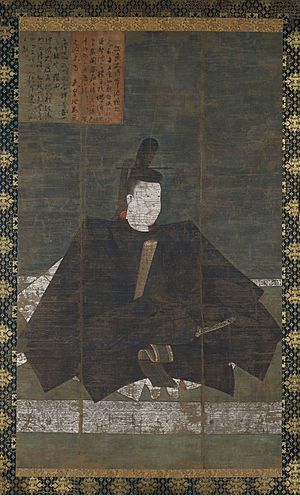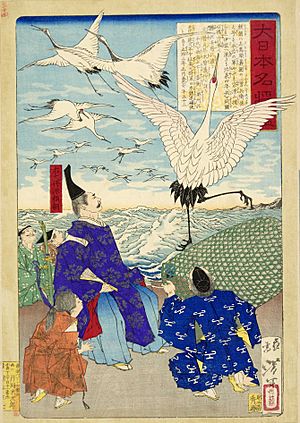Minamoto no Yoritomo facts for kids
Quick facts for kids
Minamoto no Yoritomo
|
|
|---|---|
|
源 頼朝
|
|
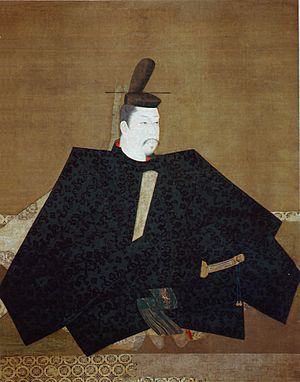
Portrait by Fujiwara no Takanobu, 1179
|
|
| Shogun | |
| In office July 12, 1192 – February 9, 1199 |
|
| Monarch | Go-Toba |
| Preceded by | Shogunate established |
| Succeeded by | Minamoto no Yoriie |
| Head of the Kawachi Genji | |
| Preceded by | Minamoto no Yoshitomo |
| Succeeded by | Minamoto no Yoriie |
| Personal details | |
| Born | May 9, 1147 Atsuta, Owari Province |
| Died | February 9, 1199 (aged 51) Kamakura, Kamakura shogunate |
| Nationality | Japanese |
| Spouse | Hōjō Masako |
| Relations |
|
| Children |
|
| Parents |
|
| Relatives |
|
| Signature |  |
Minamoto no Yoritomo (源 頼朝, May 9, 1147 – February 9, 1199) was a very important leader in Japan. He founded the Kamakura shogunate and became Japan's first shogun. A shogun was like a military ruler. He led Japan from 1192 until 1199.
Yoritomo was married to Hōjō Masako. After he died, she became a powerful leader herself. Yoritomo belonged to a famous family called the Minamoto clan. He led his family in a big war against another powerful family, the Taira clan. This war was called the Genpei War.
He won the war in 1185 and started a new kind of government in Kamakura. This government was led by samurai warriors. This began a long period in Japanese history called the feudal age. It lasted for many centuries.
Contents
Early Life and Family
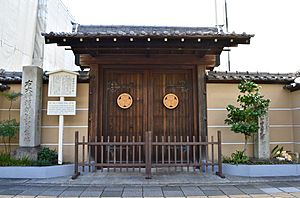
Minamoto no Yoritomo was born on May 9, 1147. He was the third son of Minamoto no Yoshitomo, who was the leader of the Minamoto clan. His mother was Yura-Gozen. She came from another important family, the Fujiwara clan. Yoritomo was born in his family's home in Atsuta, which is now part of Nagoya. His childhood name was Oniwakamaru.
When Yoritomo was young, there were many fights for power in Japan. In 1156, a conflict called the Hōgen Rebellion happened. The Minamoto clan was split. Yoritomo's father, Yoshitomo, fought on one side with Taira no Kiyomori. They won the conflict.
A few years later, in 1160, another big fight happened called the Heiji Rebellion. This time, Yoritomo's father, Yoshitomo, and Taira no Kiyomori were on opposite sides. The Taira clan won this battle. Yoritomo's father was defeated and killed.
Because of this, Yoritomo, who was still young, was exiled. This meant he had to leave his home and live far away. He was allowed to live because Kiyomori's stepmother asked for his life to be spared. His younger brothers, Minamoto no Noriyori and Minamoto no Yoshitsune, were also allowed to live.
While in exile, Yoritomo grew up and married Hōjō Masako. She was the daughter of Hōjō Tokimasa, a powerful leader of the Hōjō clan. This marriage was very important for his future.
Family Members
Here are some of Minamoto no Yoritomo's family members:
Parents
- Father: Minamoto no Yoshitomo (born 1123, died 1160)
- Mother: Yura Gozen (died 1159)
Wife and Children
- Wife: Hōjō Masako (born 1156, died 1225)
- Ohime (born 1178, died 1197): Their first daughter.
- Minamoto no Yoriie (born 1182, died 1204): Their first son. He became shogun after Yoritomo.
- Lady Mihata (born 1186, died 1199): Their second daughter.
- Minamoto no Sanetomo (born 1192, died 1219): Their third son. He also became shogun later.
- Other children:
- Chizurumaru: Possibly his first son with Yaehime.
- Jōgyō (born 1186, died 1231): Also known as Kamamura Hōin, his second son with a concubine named Daishin no Tsubone.
The Genpei War (1180–1185)
In 1180, a prince named Prince Mochihito called on the Minamoto clan to fight against the Taira clan. Yoritomo joined this fight. He became the main leader of the Minamoto clan. He set up his headquarters in a place called Kamakura.
Not everyone in the Minamoto clan agreed that Yoritomo should be the leader. Some of his relatives, like his uncle Minamoto no Yukiie and cousin Minamoto no Yoshinaka, tried to challenge him.
Yoritomo faced his first big defeat at the Battle of Ishibashiyama in 1180. He had to escape and hide. But he didn't give up. He spent the next six months gathering a new army.
The leader of the Taira clan, Taira no Kiyomori, died in 1181. His son, Taira no Munemori, took over. The Taira clan then attacked the Minamoto bases. But Yoritomo was safe in Kamakura.
Yoritomo's brothers, Minamoto no Yoshitsune and Minamoto no Noriyori, won many battles against the Taira. In 1183, Yoritomo's rival cousin, Minamoto no Yoshinaka, entered Kyoto, the capital city. The Taira clan fled south, taking the young Emperor Antoku with them.
In 1184, the Minamoto clan replaced Emperor Antoku with a new emperor, Emperor Go-Toba. The war finally ended in 1185 with a huge victory for the Minamoto clan at the Battle of Dan-no-ura.
After this victory, Yoritomo became the most powerful leader in Japan. He made the warrior class, the samurai, very important. He created the first bakufu (military government) in Kamakura. This marked the beginning of the feudal age in Japan.
Later Years and Death
In 1189, Yoritomo expanded his power by taking control of two northern provinces, Mutsu and Dewa. In 1190, he moved into a mansion in the capital city, Kyoto.
After the death of Emperor Go-Shirakawa in 1192, the new emperor, Go-Toba, gave Yoritomo the special title of Sei-i Tai Shōgun. This meant he was the supreme military commander. With this title, Yoritomo officially established a military government in Kamakura. Kyoto remained the center for ceremonies, but Kamakura was where the real power was.
In May 1193, Yoritomo organized a large hunting event called Fuji no Makigari. His 12-year-old son, Yoriie, shot a deer for the first time. Yoritomo was very proud, but his wife Masako reminded him that a warrior's son should naturally be able to hunt.
During this hunting event, a dramatic incident known as the Revenge of the Soga Brothers took place. Two brothers, Soga Sukenari and Soga Tokimune, attacked and killed a man named Kudō Suketsune. They believed he was responsible for their father's death. The brothers caused a lot of chaos. One of them even tried to attack Yoritomo, but he was stopped. Yoritomo had the brother questioned and later executed.
In 1199, Yoritomo became a Buddhist monk. He died two days later at the age of 51.
Appearance and Personality
People who knew Minamoto no Yoritomo described him in different ways. According to an old story called The Tale of Heiji, Yoritomo seemed more grown-up than other kids his age.
Another old text, Genpei Jōsuiki, said he had a "large face and beautiful appearance." An imperial messenger who met Yoritomo in 1183 described him as "short and his face is large, his appearance is graceful and language is civilized."
A famous writer named Fujiwara no Kanezane wrote in his diary that Yoritomo was very strong and had a fierce nature. He also said Yoritomo was very clear and firm in deciding what was right and wrong.
Historians have studied portraits and statues of Yoritomo. Some believe that many statues thought to be of Yoritomo might actually be of other people. However, one statue in Zenkō-ji is thought to be a true likeness of him.
Legacy
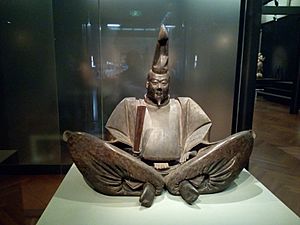
Minamoto no Yoritomo was a truly great leader. He had amazing foresight and was very practical in setting up a strong government. He created a system that lasted for many years.
After Yoritomo's death, his wife's family, the Hōjō clan, took control of the shogunate. They ruled as shikken (regents) until 1333.
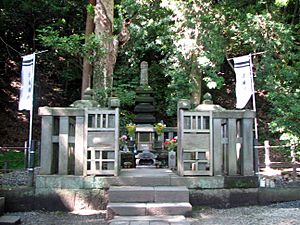
Today, you can still visit what is believed to be his grave in Kamakura. It is next to Shirahata Shrine, near where his government offices used to be.
Eras of Yoritomo's bakufu
The years when Yoritomo was shogun are known by these era names:
See also
 In Spanish: Minamoto no Yoritomo para niños
In Spanish: Minamoto no Yoritomo para niños
- Seiwa Genji
- Eiji Yoshikawa, a historical fiction writer
- Battle of Hojuji


